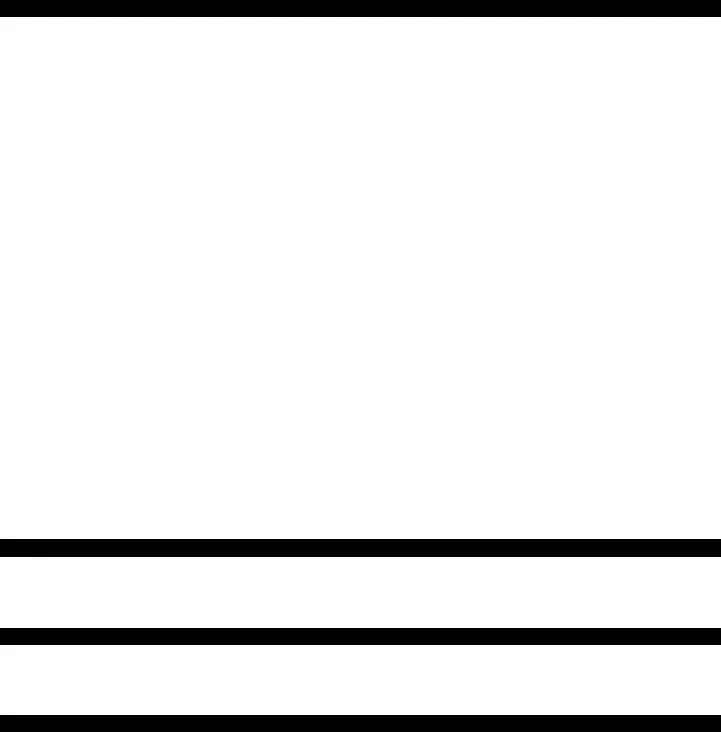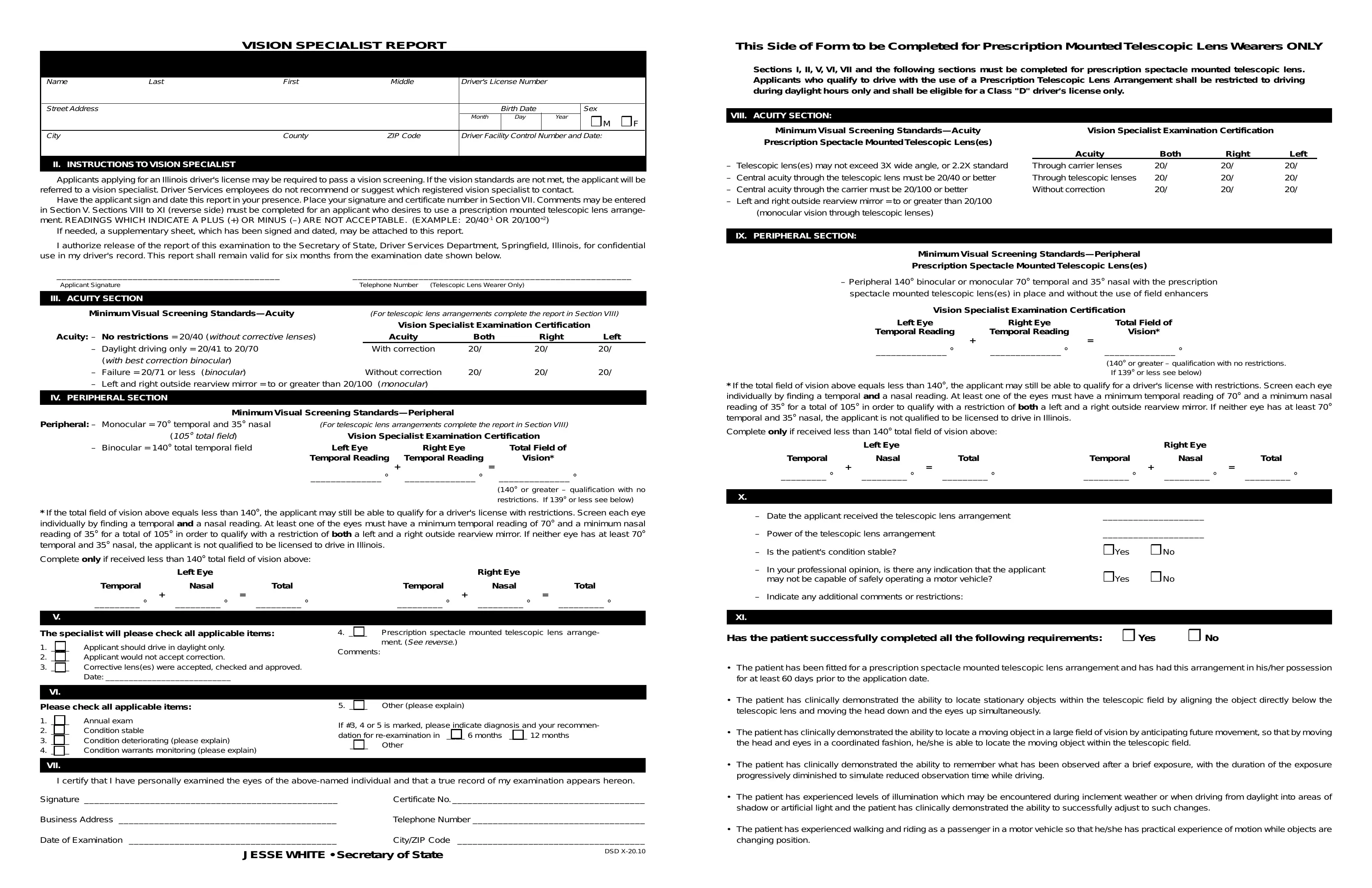
VISION SPECIALIST REPORT
|
|
|
|
|
|
|
|
|
|
Name |
Last |
First |
Middle |
Driver's License Number |
|
|
|
|
|
|
|
|
|
|
|
|
|
Street Address |
|
|
|
|
Birth Date |
|
Sex |
|
|
|
|
|
Month |
Day |
|
Year |
❒ M |
❒ F |
|
|
|
|
|
|
|
|
|
|
|
|
|
|
|
|
|
City |
|
County |
ZIP Code |
Driver Facility Control Number and Date: |
|
|
|
|
|
|
|
|
|
|
|
II. INSTRUCTIONS TO VISION SPECIALIST
Applicants applying for an Illinois driver's license may be required to pass a vision screening. If the vision standards are not met, the applicant will be referred to a vision specialist. Driver Services employees do not recommend or suggest which registered vision specialist to contact.
Have the applicant sign and date this report in your presence. Place your signature and certificate number in Section VII. Comments may be entered in Section V. Sections VIII to XI (reverse side) must be completed for an applicant who desires to use a prescription mounted telescopic lens arrange- ment. READINGS WHICH INDICATE A PLUS (+) OR MINUS (–) ARE NOT ACCEPTABLE. (EXAMPLE: 20/40-1 OR 20/100+2)
If needed, a supplementary sheet, which has been signed and dated, may be attached to this report.
I authorize release of the report of this examination to the Secretary of State, Driver Services Department, Springfield, Illinois, for confidential use in my driver's record. This report shall remain valid for six months from the examination date shown below.
____________________________________________ |
_______________________________________________________ |
Applicant Signature |
Telephone Number (Telescopic Lens Wearer Only) |
|
|
|
|
|
|
|
|
III. ACUITY SECTION |
|
|
|
|
|
|
Minimum Visual Screening Standards—Acuity |
|
(For telescopic lens arrangements complete the report in Section VIII) |
|
|
|
|
Vision Specialist Examination Certification |
Acuity: – |
No restrictions = 20/40 (without corrective lenses) |
|
|
Acuity |
Both |
Right |
Left |
– |
Daylight driving only = 20/41 to 20/70 |
|
With correction |
20/ |
20/ |
20/ |
|
(with best correction binocular) |
|
|
|
|
|
|
– |
Failure = 20/71 or less (binocular) |
|
Without correction |
20/ |
20/ |
20/ |
– |
Left and right outside rearview mirror = to or greater than 20/100 (monocular) |
|
|
|
|
|
|
|
|
|
|
IV. PERIPHERAL SECTION |
|
|
|
|
|
|
|
Minimum Visual Screening Standards—Peripheral |
|
|
|
Peripheral: – |
Monocular = 70° temporal and 35° nasal |
(For telescopic lens arrangements complete the report in Section VIII) |
|
|
(105° total field) |
Vision Specialist Examination Certification |
|
– |
Binocular = 140° total temporal field |
Left Eye |
Right Eye |
|
Total Field of |
|
|
Temporal Reading |
Temporal Reading |
Vision* |
|
|
|
|
|
+ |
= |
|
|
|
______________ ° |
______________ ° |
______________ ° |
|
|
|
|
|
|
(140° or greater – qualification with no |
|
|
|
|
|
|
restrictions. If 139° |
or less see below) |
*If the total field of vision above equals less than 140° , the applicant may still be able to qualify for a driver's license with restrictions. Screen each eye individually by finding a temporal and a nasal reading. At least one of the eyes must have a minimum temporal reading of 70° and a minimum nasal reading of 35° for a total of 105° in order to qualify with a restriction of both a left and a right outside rearview mirror. If neither eye has at least 70° temporal and 35° nasal, the applicant is not qualified to be licensed to drive in Illinois.
Complete only if received less than 140° total field of vision above:
|
Left Eye |
|
|
Right Eye |
|
Temporal |
Nasal |
Total |
Temporal |
Nasal |
Total |
_________ ° |
+ |
= |
_________ ° |
+ |
= |
_________ ° |
_________ ° |
_________ ° |
_________ ° |
V.
The specialist will please check all applicable items:
1. |
____ |
Applicant should drive in daylight only. |
2. |
____ |
Applicant would not accept correction. |
3. |
____ |
Corrective lens(es) were accepted, checked and approved. |
|
|
Date: ___________________________ |
4. ____ Prescription spectacle mounted telescopic lens arrange-
ment. (See reverse.)
Comments:
VI.
Please check all applicable items:
1. |
____ |
Annual exam |
2. |
____ |
Condition stable |
3. |
____ |
Condition deteriorating (please explain) |
4. |
____ |
Condition warrants monitoring (please explain) |
5. ____ Other (please explain)
If #3, 4 or 5 is marked, please indicate diagnosis and your recommen- dation for re-examination in ____ 6 months ____ 12 months
____ Other
VII.
I certify that I have personally examined the eyes of the above-named individual and that a true record of my examination appears hereon.
Signature __________________________________________________ |
Certificate No. ______________________________________ |
Business Address ___________________________________________ |
Telephone Number __________________________________ |
Date of Examination _________________________________________ |
City/ZIP Code _____________________________________ |
JESSE WHITE • Secretary of State
This Side of Form to be Completed for Prescription Mounted Telescopic Lens Wearers ONLY
Sections I, II, V, VI, VII and the following sections must be completed for prescription spectacle mounted telescopic lens. Applicants who qualify to drive with the use of a Prescription Telescopic Lens Arrangement shall be restricted to driving during daylight hours only and shall be eligible for a Class "D" driver's license only.
VIII. ACUITY SECTION: |
|
|
|
|
|
|
Minimum Visual Screening Standards—Acuity |
Vision Specialist Examination Certification |
|
|
|
Prescription Spectacle Mounted Telescopic Lens(es) |
|
|
|
|
|
|
|
Acuity |
Both |
Right |
Left |
|
– |
Telescopic lens(es) may not exceed 3X wide angle, or 2.2X standard |
Through carrier lenses |
20/ |
20/ |
20/ |
|
– |
Central acuity through the telescopic lens must be 20/40 or better |
Through telescopic lenses |
20/ |
20/ |
20/ |
|
– |
Central acuity through the carrier must be 20/100 or better |
Without correction |
20/ |
20/ |
20/ |
|
–Left and right outside rearview mirror = to or greater than 20/100 (monocular vision through telescopic lenses)
IX. PERIPHERAL SECTION:
Minimum Visual Screening Standards—Peripheral
Prescription Spectacle Mounted Telescopic Lens(es)
–Peripheral 140° binocular or monocular 70° temporal and 35° nasal with the prescription spectacle mounted telescopic lens(es) in place and without the use of field enhancers
Vision Specialist Examination Certification
Left Eye |
Right Eye |
Total Field of |
Temporal Reading |
Temporal Reading |
Vision* |
|
+ |
= |
______________ ° |
______________ ° |
______________ ° |
|
|
(140° or greater – qualification with no restrictions. |
|
|
If 139° or less see below) |
*If the total field of vision above equals less than 140° , the applicant may still be able to qualify for a driver's license with restrictions. Screen each eye individually by finding a temporal and a nasal reading. At least one of the eyes must have a minimum temporal reading of 70° and a minimum nasal reading of 35° for a total of 105° in order to qualify with a restriction of both a left and a right outside rearview mirror. If neither eye has at least 70° temporal and 35° nasal, the applicant is not qualified to be licensed to drive in Illinois.
Complete only if received less than 140° total field of vision above: |
|
|
|
|
|
|
Left Eye |
|
|
|
|
Right Eye |
|
Temporal |
Nasal |
Total |
Temporal |
|
Nasal |
Total |
_________ ° |
+ |
= |
_________ ° |
+ |
_________ ° |
= |
_________ ° |
_________ ° |
|
_________ ° |
|
|
|
|
|
|
|
|
X. |
|
|
|
|
|
|
|
– Date the applicant received the telescopic lens arrangement |
|
____________________ |
|
– Power of the telescopic lens arrangement |
|
____________________ |
|
– Is the patient's condition stable? |
|
|
❒Yes |
❒ No |
|
– In your professional opinion, is there any indication that the applicant |
|
❒Yes |
❒ No |
|
may not be capable of safely operating a motor vehicle? |
|
|
– Indicate any additional comments or restrictions: |
|
|
|
|
|
|
|
|
|
|
|
|
|
XI. |
|
|
|
|
|
|
|
Has the patient successfully completed all the following requirements: |
❒ Yes |
❒ No |
|
•The patient has been fitted for a prescription spectacle mounted telescopic lens arrangement and has had this arrangement in his/her possession for at least 60 days prior to the application date.
•The patient has clinically demonstrated the ability to locate stationary objects within the telescopic field by aligning the object directly below the telescopic lens and moving the head down and the eyes up simultaneously.
•The patient has clinically demonstrated the ability to locate a moving object in a large field of vision by anticipating future movement, so that by moving the head and eyes in a coordinated fashion, he/she is able to locate the moving object within the telescopic field.
•The patient has clinically demonstrated the ability to remember what has been observed after a brief exposure, with the duration of the exposure progressively diminished to simulate reduced observation time while driving.
•The patient has experienced levels of illumination which may be encountered during inclement weather or when driving from daylight into areas of shadow or artificial light and the patient has clinically demonstrated the ability to successfully adjust to such changes.
•The patient has experienced walking and riding as a passenger in a motor vehicle so that he/she has practical experience of motion while objects are changing position.






